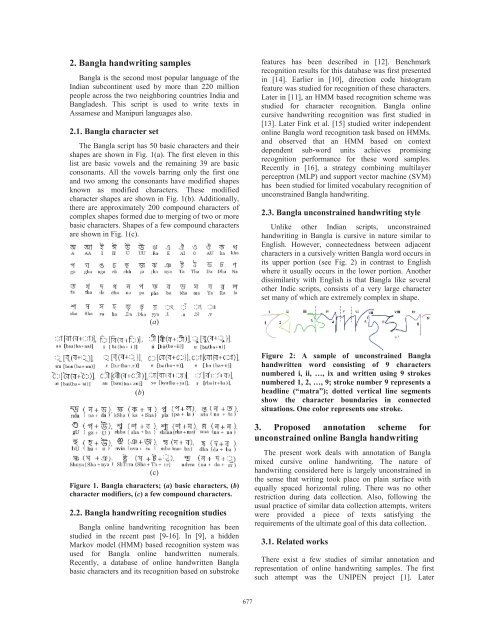A Semi-automatic Annotation Scheme for Bangla Online ... - icfhr-2012
A Semi-automatic Annotation Scheme for Bangla Online ... - icfhr-2012
A Semi-automatic Annotation Scheme for Bangla Online ... - icfhr-2012
You also want an ePaper? Increase the reach of your titles
YUMPU automatically turns print PDFs into web optimized ePapers that Google loves.
2. <strong>Bangla</strong> handwriting samples<br />
<strong>Bangla</strong> is the second most popular language of the<br />
Indian subcontinent used by more than 220 million<br />
people across the two neighboring countries India and<br />
<strong>Bangla</strong>desh. This script is used to write texts in<br />
Assamese and Manipuri languages also.<br />
2.1. <strong>Bangla</strong> character set<br />
The <strong>Bangla</strong> script has 50 basic characters and their<br />
shapes are shown in Fig. 1(a). The first eleven in this<br />
list are basic vowels and the remaining 39 are basic<br />
consonants. All the vowels barring only the first one<br />
and two among the consonants have modified shapes<br />
known as modified characters. These modified<br />
character shapes are shown in Fig. 1(b). Additionally,<br />
there are approximately 200 compound characters of<br />
complex shapes <strong>for</strong>med due to merging of two or more<br />
basic characters. Shapes of a few compound characters<br />
are shown in Fig. 1(c).<br />
(b)<br />
(a)<br />
(c)<br />
Figure 1. <strong>Bangla</strong> characters; (a) basic characters, (b)<br />
character modifiers, (c) a few compound characters.<br />
2.2. <strong>Bangla</strong> handwriting recognition studies<br />
<strong>Bangla</strong> online handwriting recognition has been<br />
studied in the recent past [9-16]. In [9], a hidden<br />
Markov model (HMM) based recognition system was<br />
used <strong>for</strong> <strong>Bangla</strong> online handwritten numerals.<br />
Recently, a database of online handwritten <strong>Bangla</strong><br />
basic characters and its recognition based on substroke<br />
677<br />
features has been described in [12]. Benchmark<br />
recognition results <strong>for</strong> this database was first presented<br />
in [14]. Earlier in [10], direction code histogram<br />
feature was studied <strong>for</strong> recognition of these characters.<br />
Later in [11], an HMM based recognition scheme was<br />
studied <strong>for</strong> character recognition. <strong>Bangla</strong> online<br />
cursive handwriting recognition was first studied in<br />
[13]. Later Fink et al. [15] studied writer independent<br />
online <strong>Bangla</strong> word recognition task based on HMMs.<br />
and observed that an HMM based on context<br />
dependent sub-word units achieves promising<br />
recognition per<strong>for</strong>mance <strong>for</strong> these word samples.<br />
Recently in [16], a strategy combining multilayer<br />
perceptron (MLP) and support vector machine (SVM)<br />
has been studied <strong>for</strong> limited vocabulary recognition of<br />
unconstrained <strong>Bangla</strong> handwriting.<br />
2.3. <strong>Bangla</strong> unconstrained handwriting style<br />
Unlike other Indian scripts, unconstrained<br />
handwriting in <strong>Bangla</strong> is cursive in nature similar to<br />
English. However, connectedness between adjacent<br />
characters in a cursively written <strong>Bangla</strong> word occurs in<br />
its upper portion (see Fig. 2) in contrast to English<br />
where it usually occurs in the lower portion. Another<br />
dissimilarity with English is that <strong>Bangla</strong> like several<br />
other Indic scripts, consists of a very large character<br />
set many of which are extremely complex in shape.<br />
Figure 2: A sample of unconstrained <strong>Bangla</strong><br />
handwritten word consisting of 9 characters<br />
numbered i, ii, …, ix and written using 9 strokes<br />
numbered 1, 2, …, 9; stroke number 9 represents a<br />
headline (“matra”); dotted vertical line segments<br />
show the character boundaries in connected<br />
situations. One color represents one stroke.<br />
3. Proposed annotation scheme <strong>for</strong><br />
unconstrained online <strong>Bangla</strong> handwriting<br />
The present work deals with annotation of <strong>Bangla</strong><br />
mixed cursive online handwriting. The nature of<br />
handwriting considered here is largely unconstrained in<br />
the sense that writing took place on plain surface with<br />
equally spaced horizontal ruling. There was no other<br />
restriction during data collection. Also, following the<br />
usual practice of similar data collection attempts, writers<br />
were provided a piece of texts satisfying the<br />
requirements of the ultimate goal of this data collection.<br />
3.1. Related works<br />
There exist a few studies of similar annotation and<br />
representation of online handwriting samples. The first<br />
such attempt was the UNIPEN project [1]. Later


